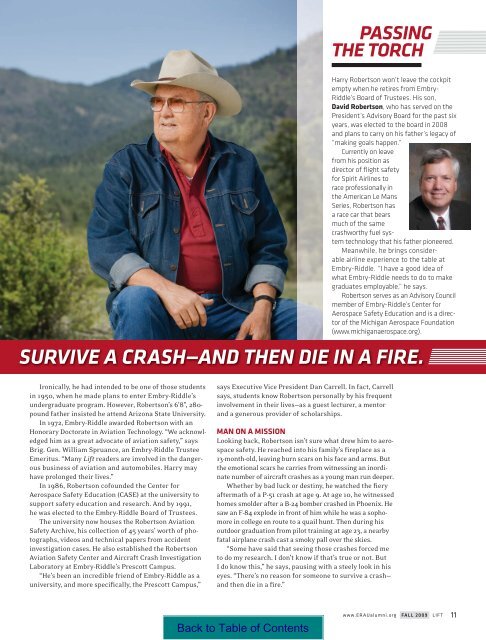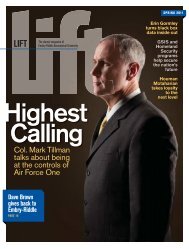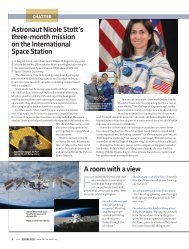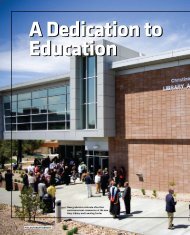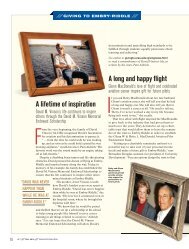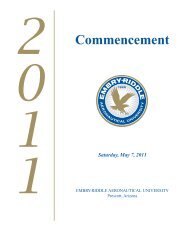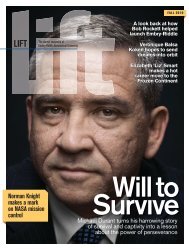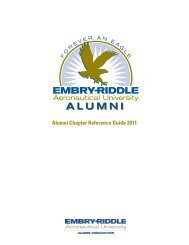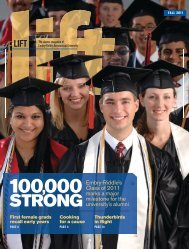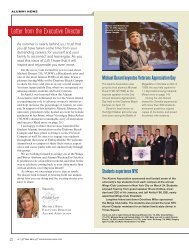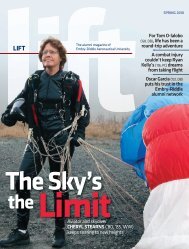Fall 2009 Issue - Embry-Riddle Aeronautical University Alumni
Fall 2009 Issue - Embry-Riddle Aeronautical University Alumni
Fall 2009 Issue - Embry-Riddle Aeronautical University Alumni
You also want an ePaper? Increase the reach of your titles
YUMPU automatically turns print PDFs into web optimized ePapers that Google loves.
PASSING<br />
THE TORCH<br />
Harry Robertson won’t leave the cockpit<br />
empty when he retires from <strong>Embry</strong>-<br />
<strong>Riddle</strong>’s Board of Trustees. His son,<br />
David Robertson, who has served on the<br />
President’s Advisory Board for the past six<br />
years, was elected to the board in 2008<br />
and plans to carry on his father’s legacy of<br />
“making goals happen.”<br />
Currently on leave<br />
from his position as<br />
director of flight safety<br />
for Spirit Airlines to<br />
race professionally in<br />
the American Le Mans<br />
Series, Robertson has<br />
a race car that bears<br />
much of the same<br />
crashworthy fuel system<br />
technology that his father pioneered.<br />
Meanwhile, he brings considerable<br />
airline experience to the table at<br />
<strong>Embry</strong>-<strong>Riddle</strong>. “I have a good idea of<br />
what <strong>Embry</strong>-<strong>Riddle</strong> needs to do to make<br />
graduates employable,” he says.<br />
Robertson serves as an Advisory Council<br />
member of <strong>Embry</strong>-<strong>Riddle</strong>’s Center for<br />
Aerospace Safety Education and is a director<br />
of the Michigan Aerospace Foundation<br />
(www.michiganaerospace.org).<br />
SURVIVE A CRASH—AND THEN DIE IN A FIRE.<br />
Ironically, he had intended to be one of those students<br />
in 1950, when he made plans to enter <strong>Embry</strong>-<strong>Riddle</strong>’s<br />
undergraduate program. However, Robertson’s 6'8", 280-<br />
pound father insisted he attend Arizona State <strong>University</strong>.<br />
In 1972, <strong>Embry</strong>-<strong>Riddle</strong> awarded Robertson with an<br />
Honorary Doctorate in Aviation Technology. “We acknowledged<br />
him as a great advocate of aviation safety,” says<br />
Brig. Gen. William Spruance, an <strong>Embry</strong>-<strong>Riddle</strong> Trustee<br />
Emeritus. “Many Lift readers are involved in the dangerous<br />
business of aviation and automobiles. Harry may<br />
have prolonged their lives.”<br />
In 1986, Robertson cofounded the Center for<br />
Aerospace Safety Education (CASE) at the university to<br />
support safety education and research. And by 1991,<br />
he was elected to the <strong>Embry</strong>-<strong>Riddle</strong> Board of Trustees.<br />
The university now houses the Robertson Aviation<br />
Safety Archive, his collection of 45 years’ worth of photographs,<br />
videos and technical papers from accident<br />
investigation cases. He also established the Robertson<br />
Aviation Safety Center and Aircraft Crash Investigation<br />
Laboratory at <strong>Embry</strong>-<strong>Riddle</strong>’s Prescott Campus.<br />
“He’s been an incredible friend of <strong>Embry</strong>-<strong>Riddle</strong> as a<br />
university, and more specifically, the Prescott Campus,”<br />
says Executive Vice President Dan Carrell. In fact, Carrell<br />
says, students know Robertson personally by his frequent<br />
involvement in their lives—as a guest lecturer, a mentor<br />
and a generous provider of scholarships.<br />
MAN ON A MISSION<br />
Looking back, Robertson isn’t sure what drew him to aerospace<br />
safety. He reached into his family’s fireplace as a<br />
13-month-old, leaving burn scars on his face and arms. But<br />
the emotional scars he carries from witnessing an inordinate<br />
number of aircraft crashes as a young man run deeper.<br />
Whether by bad luck or destiny, he watched the fiery<br />
aftermath of a P-51 crash at age 9. At age 10, he witnessed<br />
homes smolder after a B-24 bomber crashed in Phoenix. He<br />
saw an F-84 explode in front of him while he was a sophomore<br />
in college en route to a quail hunt. Then during his<br />
outdoor graduation from pilot training at age 23, a nearby<br />
fatal airplane crash cast a smoky pall over the skies.<br />
“Some have said that seeing those crashes forced me<br />
to do my research. I don’t know if that’s true or not. But<br />
I do know this,” he says, pausing with a steely look in his<br />
eyes. “There’s no reason for someone to survive a crash—<br />
and then die in a fire.”<br />
www.ERAUalumni.org FALL <strong>2009</strong> LIFT 11


